- About us»
- Net income calculator»
- Population aging»
-
- Least developed regions»
-
- Material need benefits
- Meal allowance
- Counties of Slovakia
- Average wage and inflation
- Living and Subsistence Minimum
- Unemployment of Czechia and Slovakia
- NACE Classification
-
- Life expectancy
- Gender differences
- Youth unemployment and NEET
- Minimum wage in EU
- Unemployment rates of different age groups
- Share of salaries on GDP
- Employment of mothers of more than 3 children
- Percentage of employees ususally working on Sunday
- Long term unemployment
- Employment rate
- NEET
- Unemployment rate
- Percentage of employees ususally working at nights
-
- Bratislava and surroundings
- Kopanice
- Danube river
- lower Vah river
- middle Vár river
- upper Nitra river
- lower Nitra river
- Mining cities
- Kysuce a Orava
- upper Vah river - Liptov
- Spiš cities
- upper Hron river
- Juhoslovenská kotlina
- Košice fold and Torysa river
- upper Zemplín
- lower Zemplín
- EU regions
- NUTS3 regions of Slovakia
- LAU1 dataset
-
- Projects and activities
- Inclusive growth»
- Good work
- Project SKRS
- Social system – reality and vision
-
- Education of unemployed
- Young unemployed not taking part in education
- Proposal to change the system of education funding
- Library
- News»
- Contact
Denmark – DK
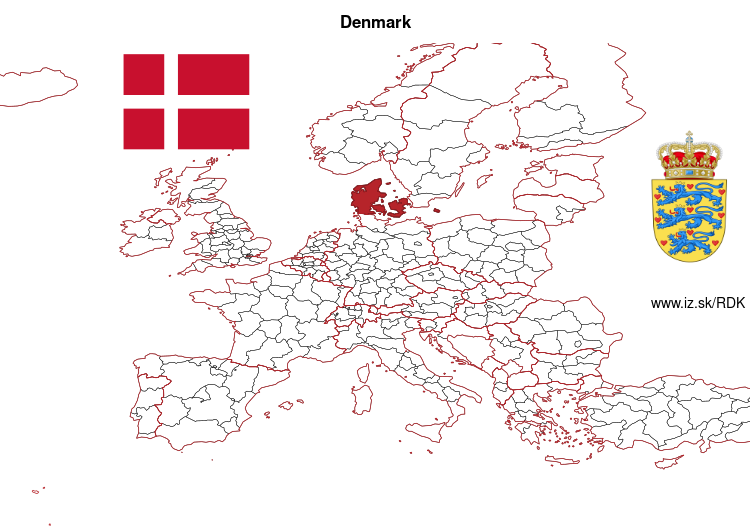
More on wikipedia wikidata Q35 on OpenStreetMap Denmark slovensky: DK
Subregions: Denmark, Capital Region of Denmark, Region Zealand, Southern Denmark, Central Denmark Region, North Denmark Region
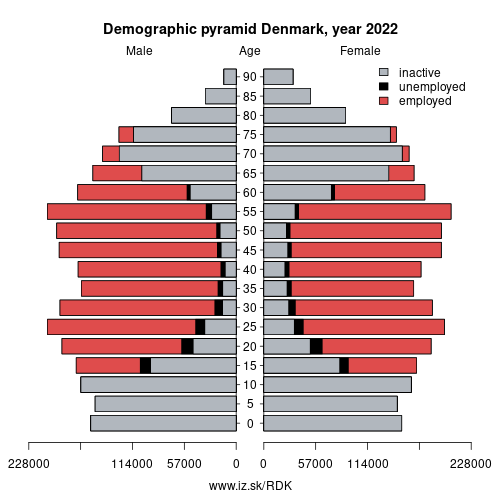
Unemployment
| Indicator | Period | Value |
|---|---|---|
| Unemployment | ||
| unemployment rate | 2022 | 4.5 |
| youth unemployment rate | 2022 | 10.6 |
| unemployment rate of low educated people | 2023q4 | 10.9 |
| Long term unemployment | ||
| long term unemployment | 2022 | 0.5 |
| share of long term unemployed | 2023q4 | 10.7 |
Composition of population according to age group, education and economic activity, Denmark
| Age group | Low education | Middle education | High education |
|---|---|---|---|
| Y20-29 | P: 161.8 E: 95.7; U: 10.0; I: 56.1 | P: 392.6 E: 290.2; U: 21.0; I: 81.4 | P: 217.0 E: 181.0; U: 14.8; I: 21.2 |
| Y30-39 | P: 122.0 E: 76.4; U: 5.5; I: 40.1 | P: 229.6 E: 193.9; U: 6.7; I: 29.0 | P: 366.8 E: 330.8; U: 13.6; I: 22.4 |
| Y40-49 | P: 109.9 E: 76.4; U: 4.2; I: 29.3 | P: 288.9 E: 258.1; U: 6.2; I: 24.6 | P: 330.5 E: 304.6; U: 7.2; I: 18.7 |
| Y50-59 | P: 152.7 E: 105.0; U: 4.4; I: 43.3 | P: 371.9 E: 322.2; U: 8.6; I: 41.1 | P: 282.9 E: 256.1; U: 4.9; I: 21.9 |
| Y60-69 | P: 191.4 E: 64.6; U: 2.9; I: 123.9 | P: 290.5 E: 134.0; U: 3.9; I: 152.6 | P: 199.6 E: 102.6; U: 2.6; I: 94.4 |
Note: in thousands in 2022, according to labour force sample survey. P – total population, E – employed, U – unemployed, I – number of ecnomically inactive
Demographics
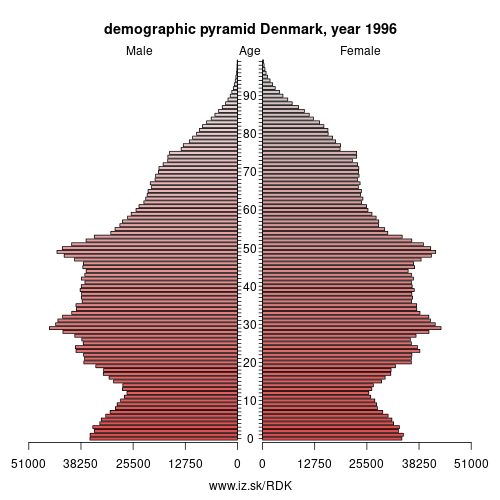
| Indicator | Period | Value |
|---|---|---|
| Demographics | ||
| number of inhabitants | 2023 | 5.932654e+06 |
| population density | 2022 | 140.6 |
| old-age dependency ratio | 2023 | 32.2 |
| Population ageing | ||
| unemployment rate – over 55 years | 2023q4 | 4 |
| aggregate replacement ratio | 2023 | 0.47 |
| aggregate replacement ratio – females | 2023 | 0.5 |
| life expectancy of a 50 year old | 2021 | 32.8 |
| healty life expectancy at 50 years | 2021 | 17.9 |
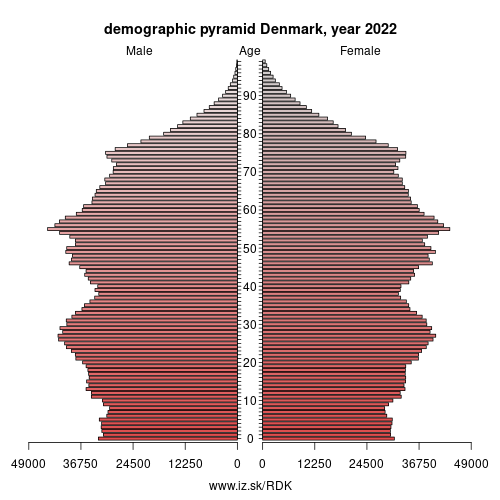
Employment by sectors, Denmark
| NACE r2 | % | NACE r2 | % | ||
|---|---|---|---|---|---|
| A | 63.2 | 2 % | B-E | 374.7 | 13 % |
| F | 194.4 | 6 % | G-I | 691.5 | 23 % |
| J | 130.2 | 4 % | K | 83.3 | 3 % |
| L | 39.2 | 1 % | M_N | 284.8 | 10 % |
| NRP | 10.9 | 0 % | O-Q | 969.3 | 32 % |
| R-U | 152.8 | 5 % | TOTAL | 2994.4 | 100 % |
Data for the period year 2022. Source of the data is Eurostat, table [lfst_r_lfe2en2].
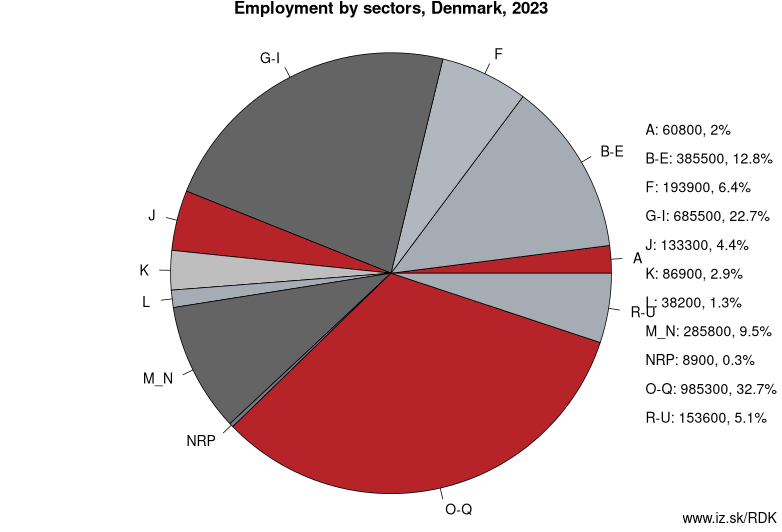
From Wikipedia: Denmark (Danish: Danmark, pronounced [ˈtænmɑk] (listen)), officially the Kingdom of Denmark, is a Nordic country in Northern Europe. Denmark proper, which is the southernmost of the Scandinavian countries, consists of a peninsula, Jutland, and an archipelago of 443 named islands, with the largest being Zealand, Funen and the North Jutlandic Island. The islands are characterised by flat, arable land and sandy coasts, low elevation and a temperate climate. Denmark lies southwest of Sweden and south of Norway, and is bordered to the south by Germany. The Kingdom of Denmark is constitutionally a unitary state comprising Denmark proper and the two autonomous territories in the North Atlantic Ocean: the Faroe Islands and Greenland. Denmark has a total area of 42,943 km2 (16,580 sq mi) as of 2020, and the total area including Greenland and the Faroe Islands is 2,210,579 km2 (853,509 sq mi). Denmark proper has a population of 5.83 million (as of 2020).
The unified kingdom of Denmark emerged in the 8th century as a proficient seafaring nation in the struggle for control of the Baltic Sea. Denmark, Sweden, and Norway were ruled together under one sovereign ruler in the Kalmar Union, established in 1397 and ending with Swedish secession in 1523. The areas of Denmark and Norway remained under the same monarch until 1814, Denmark–Norway. Beginning in the 17th century, there were several devastating wars with the Swedish Empire, ending with large cessions of territory to Sweden.
Neighbours: Germany
Subregions: Denmark, Capital Region of Denmark, Region Zealand, Southern Denmark, Central Denmark Region, North Denmark Region
Suggested citation: Michal Páleník: Europe and its regions in numbers - Denmark – DK, IZ Bratislava, retrieved from: https://www.iz.sk/PDK, ISBN: 978-80-970204-9-1, DOI:10.5281/zenodo.10200164

 Share
Share Facebook
Facebook Twitter
Twitter News
News